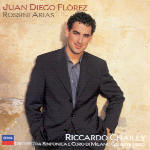As is now common knowledge, Maria Callas, Joan Sutherland, Leyla Gencer, Beverly Sills, and Marilyn Horne (among others) re-introduced the world to the bel canto operas beginning in the 1950s. In so doing they unearthed great, fascinating, technically challenging works that had fallen by the wayside in the wake of the verismo–and other–movements. All that was lacking in their performances of operas such as Il turco in Italia, Semiramide, I Puritani, L’Italiana in Algeri and others was a tenor who could keep up with them and sing the high-flying, intricate music the composers had (unfortunately) set in front of them. So we got Luigi Alva, Nicola Monti, and a few other classy, light-voiced tenors with style but little agility and no notes above B-natural. And so they left out not only the high notes, but most of the fiorature. (Cesare Valletti was the exception as far as the “little notes” were concerned, but his top extension was not sufficiently developed; the wonderful Alfredo Kraus had the opposite situation.)
The past two decades have corrected this problem, but almost every superb member of this newer generation has been deficient in some aspect: Chris Merritt and Rockwell Blake had everything but the tonal beauty to put the “bel” in bel canto; Raul Gimenez is wonderful but lacks the ultimate agility and really high notes; William Matteuzzi’s tone color is an issue; and Bruce Ford is not interested in the truly light roles. Now along comes Juan Diego Florez, a 28-year-old Peruvian, and judging from this Rossini recital (and some superb work on a couple of other Rossini-filled CDs), he’s got it all.
The sound is sweet and warm, the breath control superb, the ability to articulate long upward or downward coloratura passages seemingly easy. The voice retains its round, full quality up to a high D-natural, which fits nicely into a showy roulade as easily as it is stabbed at from an octave or two below it. While you are being dazzled by the precision, you’re also taken by the beauty of the tone. On this recording Florez sings some of Rossini’s most demanding music; a couple of the arias never have been recorded before, and the ones that have, even by the best of the “new” bel cantists mentioned above, are sung here with more expression, virtuosity, and/or loveliness.
The impression we’re left with is that Florez finds song as natural as speech; his ease of execution is like that of a perfectly-in-shape, expertly trained ballet dancer or downhill skier. Decca has wisely gone all out and supplied Florez not only with a fine, Rossini-wise conductor, good orchestra, and excellent recording (Rossini’s wind writing is clear and crisp), but with a full chorus for the larger scenes, thereby turning the arias in which they belong into the dazzling “events” Rossini meant for them to be. No lover of great singing or Rossini should be without this CD. Let’s hope that Florez will husband his resources, stick with the music that best suits him, and offer us years of great singing. [2/23/2002]
































